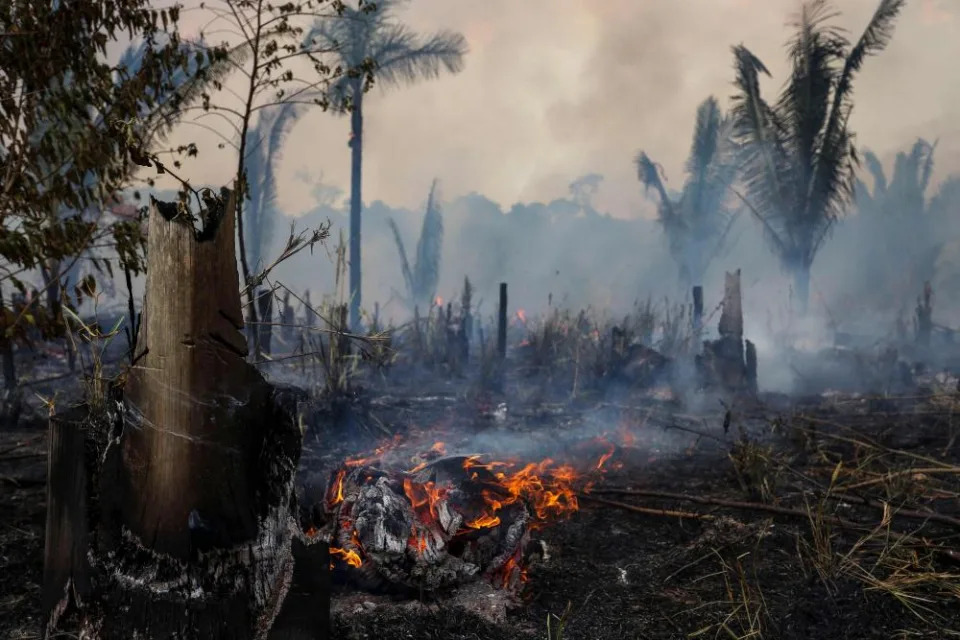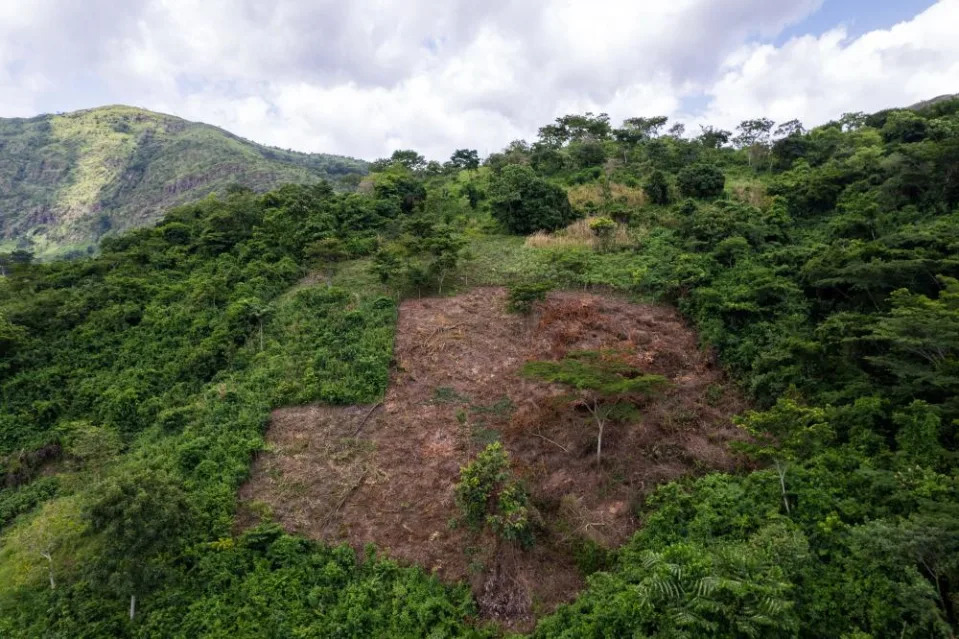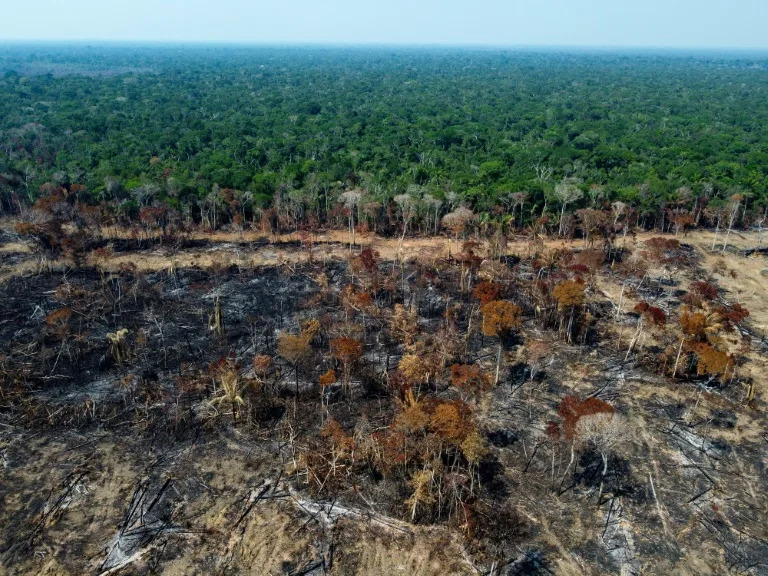Scottish migration minister: UK Illegal Migration Bill ‘violates human rights’
Lauren Gilmour, PA Scotland
Tue, 27 June 2023
The UK Government’s controversial Illegal Migration Bill “violates human rights”, the Scottish migration minister has said.
Emma Roddick said Scottish Government would develop “reasonable mitigations” for the Bill, ahead of leading a debate on the legislation at Holyrood.
The Scottish Government says the proposed law will undermine the devolution settlement by restricting the powers of ministers and remove the entitlement of a significant number of human trafficking victims to access support.
If passed, the Bill would see the law changed so that people who come to the UK illegally through a safe country are not allowed to stay – instead being detained and removed, either to their home country or a safe third country such as Rwanda.
It is back in the House of Lords on Wednesday.

Migration minister Emma Roddick will lead a debate on the UK Government’s controversial illegal migration bill (Fraser Bremner/PA)
Ms Roddick said: “We have been clear in our opposition to the UK Government’s Illegal Migration Bill, which violates human rights obligations and will push some of society’s most vulnerable people deeper into exploitation and destitution.
“The Bill will also hinder the ability of Scottish Ministers to provide support and assistance to people who have been exploited in horrific situations.
“It is our view that this overreaches into the Scottish Parliament’s devolved competencies, undermining our commitments to victims of trafficking and exploitation
“Scottish Ministers and wider civic society are united in our stance that this Bill has no place in Scotland.
“We will continue to work closely with stakeholders to develop reasonable mitigations against the impacts of the Bill, within our devolved powers and budget.”
Maggie Chapman, the Scottish Greens’ justice spokesperson, called the Bill “the most extreme and racist piece of legislation” she could remember and called for it to be fought in the international human rights court.
She added: “The Scottish Government and our Parliament must stand with local authorities, public bodies and third sector agencies who, despite the immense hostility of the Home Office, are doing invaluable work with vulnerable people.
“Scotland is a nation of immigrants, and immigrants are an important part of our country’s future. We want to be open and welcoming to those who seek refuge here, wherever they come from.”
Scottish faith leaders have also joined forces to voice their opposition to the Bill, with the Church of Scotland, the Episcopal Church, the United Reformed Church and the Chief Imam of the Scottish Ahlul Bayt Society called for more compassion to be shown to some of the most vulnerable people on earth.
Religious leaders have joined others across the UK to feature in a video produced by Together with Refugees, a coalition of more than 500 national and local organisations representing refugees who believe in showing compassion to people fleeing their homes.
Scottish Parliament officials have said the Bill does not meet the criteria for lodging a legislative consent memorandum, which would require Holyrood’s consent to the legislation.
A Home Office spokesperson said: “Through the Illegal Migration Bill, we will stop the boats by detaining those who come to the UK illegally and swiftly returning them to a safe third country or their home country.
“It is only right that we protect the most vulnerable by not creating incentives for criminal gangs to target specific groups.
“We have amended the Bill to make clear that an unaccompanied child under 18 can only be removed in very limited circumstances. Where a removal decision is made, detention will be for the shortest possible time with necessary support provisions in place.”
Glasgow academic backs ban on sale of single use vapes
Kirsty Feerick
Updated Tue, 27 June 2023

David Webster is a Neighbourhood Improve Volunteer (Image: Sourced)
A Glasgow academic has backed a ban on the sale of single use vapes.
David Webster, a Neighbourhood Improve Volunteer, is fed up after collecting dozens of single-use vapes discarded near his home.
He regularly carries out litter picks in Cathcart while out walking and running in the street and nearby Linn Park.
David, a researcher at Glasgow University, is concerned about the impact of vapes on the health of young people as well as the environmental impact.
The Cathcart resident said: “I would be in favour of banning disposable vapes.
“They are addictive and deliberately marketed at young people with sweet fruit flavours which is an absolute disgrace.
“The plastic is not biodegradable and is harmful to the environment.
“The batteries in vapes are also a fire risk if disposed of in household bins and they also contain lithium which is a valuable resource and should be reclaimed. “I’m seeing more and more vapes dropped in the streets when I’m out for my walks.”
Keen amateur pianist, David, keeps the vapes he collects separate from the other litter and takes them to Polmadie recycling centre for safe disposal.
Glasgow has over 550 Neighbourhood Improvement Volunteers (NIVs) who carry out regular litter picks in their neighbourhoods with support from the council.
David has been a NIV for almost 15 years said: “Doing something proactive about litter in my area contributes to a positive mental attitude. Instead of feeling annoyed by litter I get a sense of satisfaction.
"Obviously, it would be better if people didn’t drop litter – I think that is mostly due to laziness - but seeing the difference in the street after I’ve been out is rewarding. I think more people should adopt a small area close to them and uplift litter when out for a walk. If we all picked up a bit of litter when we passed it, there would be a real improvement.”
In March, Glasgow’s Environment and Liveable Neighbourhoods Committee wrote to the Scottish Government to back calls for the introduction of new legislation banning the sale of single use vapes due to concerns about the future health of the city's young people and the rising environmental impact of littering.
Councillor Elaine McSporran, Chair of the committee, said: "I have grave concerns about single use vapes, both in relation to their environmental impact and the impact on people's health in years to come.
“They are made of plastic which, as we know, takes decades to degrade and can end up in our rivers and oceans where it is a threat to wildlife and can get into the food chain.
“They are also powered by lithium batteries which contain corrosive and flammable chemicals.
"Their apparent marketing towards younger people with sweet flavours and brightly coloured packaging is another concern as more and more young people seem to be using them.
"I wholeheartedly support the introduction of a ban on their sale and urge the Scottish Government to act now to avert a dual disaster in the future."
The Scottish Government is currently conducting a review of single-use vapes which includes consideration of a ban. The review is led by Zero Waste Scotland.
US reports local malaria cases for first time in 20 years as EU warns about mosquito-borne illness
Lauren Chadwick
Tue, 27 June 2023

US reports local malaria cases for first time in 20 years as EU warns about mosquito-borne illness
US health authorities have issued a warning about malaria after two states reported locally acquired cases of the disease for the first time in two decades.
There have been four reported cases of malaria in Florida and one case in Texas, the US Centres for Disease Control and Prevention (CDC) said in the health alert.
Malaria is a serious and potentially life-threatening disease that is transmitted by some types of mosquitoes.
There were an estimated 247 million cases globally in 2021 with 95 per cent occurring in Africa, according to the World Health Organization (WHO).
Mild symptoms of malaria can include fever, chills and headache while more severe symptoms can include seizures, fatigue, and difficulty breathing.
“Mosquito surveillance and control measures have been implemented in the affected area,” the CDC said in a statement.
Before the COVID-19 pandemic, there were around 2,000 cases of malaria reported in the US each year, most of which were travel related.
Disease-carrying mosquitoes are spreading through Europe: How can we protect ourselves?
Risk of mosquito-borne illness to increase with climate change
Scientists have warned that warming temperatures due to climate change could create conditions that favour the spread of mosquitoes.
The European Centres for Disease Prevention and Control (ECDC) said last week that the Asian tiger mosquito, a vector of dengue and chikungunya viruses, has established itself further north and west in Europe.
“If this continues, we can expect to see more cases and possibly deaths from diseases such as dengue, chikungunya and West Nile fever,” said ECDC director Andrea Ammon in a statement.
“Efforts need to focus on ways to control mosquito populations, enhancing surveillance and enforcing personal protective measures”.
More than 1,000 cases of West Nile virus and more than 71 cases of dengue were locally acquired in the EU and European Economic Area in 2022, according to the ECDC.
A study led by the London School of Hygiene & Tropical Medicine and published in The Lancet in 2021 estimated that if emissions are kept at current levels, an estimated 8.4 billion people could be at risk of malaria and dengue by the year 2100.
The research predicted that there would be a “northward shift” of malaria in North America, central, northern Europe and northern Asia as well as a similar shift of dengue in Europe and the northern US.
Of the 4,856 malaria cases reported in the European Union and Economic Area in 2021, 99.7 per cent were travel related with thirteen confirmed cases reported as acquired in the EU, according to the ECDC.
Current heatwave across US south made five times more likely by climate crisis
Oliver Milman in New York
Tue, 27 June 2023

Photograph: Xinhua/Shutterstock
The record heatwave roiling parts of Texas, Louisiana and Mexico was made at least five times more likely due to human-caused climate change, scientists have found, marking the latest in a series of recent extreme “heat dome” events that have scorched various parts of the world.
A stubborn ridge of high pressure has settled over Mexico and a broad swath of the southern US over the past three weeks, pushing the heat index, a combination of temperature and humidity, to above 48C (120F) in some places.
Related: About 6m across US at risk of extreme weather as over 700,000 without power
More than 40 million people in the US, including those living in the Texas cities of Houston, San Antonio and Austin, have been placed under excessive heat warnings, raising fears over the health of people vulnerable to the heat and placing Texas’s energy grid under strain from surging air conditioner use.
The heating of the Earth’s atmosphere and oceans by the burning of fossil fuels made the extreme heatwave at least five times more likely, according to a recent analysis by Climate Central, a climate science non-profit. The punishing heat, which is forecast to linger further throughout the week in Texas, is creating “stressful conditions for millions of people”, according to Andrew Pershing, vice-president for science at Climate Central.
Speaking to the Guardian on Monday, Andrew Dessler, a climate scientist at Texas A&M University said the university’s campus at College Station has had a string of days above 37C (100F), when it usually doesn’t hit such peaks until August. “It’s depressing to think we’re not even in July and we are getting this sort of heat,” he said. “When it’s this hot you are a prisoner in your own house, you are a prisoner to air conditioning.”
Dessler said that the southern part of Texas will probably have one of its hottest Junes ever recorded as it is most acutely affected by the heat dome that has its epicenter in Mexico – the Mexican cities of Monclova and Chihuahua have set all-time record temperatures of of 46C (115F) and 41C (107F), respectively.
This heat dome, one the strongest ever recorded, was formed by a high-pressure atmospheric system that created a sinking column of warming air that trapped latent heat already absorbed by the landscape, like a sort of lid. Such events typically occur without rain and are cloudless, allowing the sun to bake the surface unhindered, causing temperatures to spike.
“The heat evaporates water and then just heats up the land,” said Dessler. “If you have this sort of high-pressure system sitting stationary over a region, you can have these really impressive heatwaves.”
Heat domes have long existed in Texas, and elsewhere, and there is some conjecture among scientists as to whether or not climate change is causing more “blocking events” where patches of high pressure are held in place by alterations to a jet stream that normally pushes weather systems from west to east.
“But when these heat domes do happen, they are getting worse, that’s for certain,” said Michael Wehner, a climate and extreme weather expert at Lawrence Berkeley National Laboratory who estimated that the Texas heatwave was made around 2.7C (5F) hotter by human-caused global heating.
Extreme heat dome events have caused heightened temperatures across the world in recent times, such as the record heat and wildfires seen in May in western Canada, or the historic heat experienced in locations as varied as Puerto Rico and Siberia earlier this month.
The record warm winter experienced by many countries in Europe earlier this year, as well as a separate heatwave that scorched the continent last summer and resulted in thousands of deaths, have also been blamed, in part, upon heat domes that refused to budge.
One of the harshest heat domes on record settled over the US north-west, a place used to more temperate climes, in the summer of 2021, causing temperature records to be shattered and dozens of people to die. Last week, Oregon’s most populous county sued major oil and gas companies for billions of dollars in damages for their role in fueling the heatwave.
Scientists have calculated that the climate crisis made that heatwave 150 times more likely, with heat domes becoming ever more dangerous as the planet heats up. Limiting global heating to 1.5C (2.7F) above pre-industrial times, instead of 2C (3.6F), would halve the number of people exposed to the sort of severe heat dome conditions that caused such distress in 2021, a study has found.
Local authorities can help counter heat domes by setting up cooling centers and providing warnings and shelter to those most affected by the heat, such as the sick and the elderly, but scientists say the global heating already set in motion by the untrammeled combustion of oil, coal and gas will continue to have escalating impacts.
“It’s clear that we are way outside natural variability here,” said Wehner. “Dangerous climate change is here, now. If you don’t recognize that, you’re just not paying attention. Every summer now there’s some devastating heatwave somewhere in the world.”
Destruction of world’s pristine rainforests soared in 2022 despite Cop26 pledge
Patrick Greenfield
Tue, 27 June 2023

Photograph: Michael Dantas/AFP/Getty Images
An area the size of Switzerland was cleared from Earth’s most pristine rainforests in 2022, despite promises by world leaders to halt their destruction, new figures show.
From the Bolivian Amazon to Ghana, the equivalent of 11 football pitches of primary rainforest were destroyed every minute last year as the planet’s most carbon-dense and biodiverse ecosystems were cleared for cattle ranching, agriculture and mining, with Indigenous forest communities forced from their land by extractive industries in some countries.
The tropics lost 4.1m hectares of primary rainforest in 2022, an increase of around 10% from 2021, according to figures compiled by the World Resources Institute (WRI) and the University of Maryland. The report’s authors warn that humans are destroying one of the most effective tools for mitigating global heating and halting biodiversity loss.
Land use change is the second largest source of greenhouse gas emissions behind the burning of fossil fuels and is a major driver of biodiversity loss. Limiting global heating to 1.5C above preindustrial levels is unlikely without stopping the destruction of rainforests, according to scientists.Interactive
At Cop26 in 2021, more than 100 world leaders, including Joe Biden, Xi Jinping and Jair Bolsonaro, signed up to halt and reverse deforestation by 2030 in a commitment that covered more than 90% of the world’s forests. The new data suggests that leaders are failing to deliver on their promise.
Brazil, the Democratic Republic of the Congo (DRC) and Bolivia headed the table for tropical primary forest loss in 2022. Indonesia and Malaysia managed to keep rates of loss near record low levels after significant corporate and government action in recent years. Bolivia was one of the few big forested countries that did not sign the Cop26 commitment on stopping the loss.
Ghana, a major producer of cacao for chocolate, has suffered the biggest relative increase in forest loss of any country in recent years, although the absolute figures are small.
Away from the tropics, the loss of Russia’s boreal forests slowed after a record year for destruction in 2021, but researchers said this was not an indication of a positive trend.Interactive
In response to the new figures, Inger Andersen, the UN’s environment chief, has called for a higher price for forest carbon to eliminate the short-term economic incentive to clear rainforests. Through carbon markets, countries with forests that are critical to the climate – such as Gabon, Brazil and Peru – could receive payments to keep them standing, although there are doubts about their conservation success and ability to scale to the required size. In April, a report calculated that at least $130bn (£100bn) a year was needed to protect the most at-risk areas.
“Forests are critical for our wellbeing and the wellbeing of planet Earth. Ending deforestation and halting forest cover loss are essential ingredients to fast-tracking climate action, to building resilience and to reducing loss and damage. We need to put a higher price on forest carbon, one that reflects the true value of forests, that reflects the actual cost of emissions and that is sufficient to incentivise the sellers to protect standing forests,” Andersen said.

Deforestation for agriculture, particularly cacao farming, near the Ghana-Togo border. Photograph: Muntaka Chasant/Shutterstock
“Forest protection and forest restoration is about so much more than a carbon price. It is about protecting biodiversity; protecting the livelihoods of Indigenous people and local communities, and sustaining the hydrological cycle to stabilise weather patterns and protect ourselves against landslides, soil erosion and flooding. We simply cannot afford to lose more forest cover,” she added.
Related: What is deforestation – and is stopping it really possible?
The 2022 figures cover the final year of Jair Bolsonaro’s presidency in Brazil, during which huge areas of the Amazon were cleared. Luiz Inácio Lula da Silva, his successor, has promised to end deforestation and is holding a pan-Amazon summit later this year where the issue will be discussed.
Brazil, Indonesia and the DRC, which are home to around half of the world’s remaining rainforests, are increasingly working together at UN environmental talks to demand money for protecting forests in a coalition called the “Opec of rainforests”.
The figures describe tree-cover loss, which is not necessarily deforestation. Deforestation is always done by humans while tree cover can be lost through wildfires and other events. The figures do not include regrowth or regeneration of a forest.
Find more age of extinction coverage here, and follow biodiversity reporters Phoebe Weston and Patrick Greenfield on Twitter for all the latest news and features
Football pitch of tropical forest lost every 5 seconds
Marlowe HOOD
Tue, 27 June 2023

Nearly a football pitch of mature tropical trees were felled or burned every five seconds in 2022 (MICHAEL DANTAS)
Earth lost an area of carbon-absorbing rainforest larger than Switzerland or the Netherlands in 2022, most of it destroyed to make way for cattle and commodity crops, an analysis of satellite data released Tuesday revealed.
That is nearly a football pitch of mature tropical trees felled or burned every five seconds, night and day, and 10 percent more than the year before, according to the World Resources Institute (WRI).
Tropical forests destroyed last year released 2.7 billion tonnes of CO2 into the atmosphere, equivalent to the fossil fuel emissions of India, the world's most populous nation, the WRI's Global Forest Watch unit reported.
Brazil accounted for 43 percent of the loss, with the Democratic Republic of Congo and Bolivia responsible for about 13 and nine percent, respectively.
The more than 41,000 square kilometres (nearly 16,000 square miles) decimated globally last year makes 2022 the fourth most devastating year for primary forests in two decades.
The accelerating loss comes a year after world leaders vowed at the Glasgow COP26 summit in 2021 to halt and reverse forest loss by 2030.
"Since the turn of the century, we have seen a haemorrhaging of some of the world's most important forest ecosystems despite years of efforts to turn that trend around," Mikaela Weisse, director of WRI's Global Forest Watch told journalists in a briefing.
"We are rapidly losing one of our most effective tools for combating climate change, protecting biodiversity, and supporting the health and livelihoods of millions of people."
Globally, vegetation and soil have consistently absorbed about 30 percent of CO2 pollution since 1960, even as those emissions increased by half.
- 90 billion tonnes -
Some 1.6 billion people, nearly half of them members of indigenous groups, rely directly on forest resources for their food and livelihoods.
Deforestation in Brazil surged during the four-year rule of far-right President Jair Bolsonaro, and increased 15 percent last year compared to 2021.
Bolsonaro's administration gutted environmental policies, turned a blind eye to illegal deforestation, and weakened protections of the rights of indigenous peoples proven to be effective stewards of healthy forests.
President Luiz Inacio Lula da Silva, sworn in at the start of this year, has vowed to end deforestation in the Brazilian Amazon by 2030 but will face many challenges in doing so, experts say.
Scientists fear that climate change and deforestation combined could trigger the accelerating transition of the Amazon basin from tropical forest to savannah, which could profoundly disrupt weather not just in South America but across the globe.
Some 90 billion tonnes of CO2 is stored in the Amazon basin's forest, twice worldwide annual emissions from all sources.
"Halting and reversing forest loss is one of the most cost-effective mitigation options available to us today," said Frances Seymour, WRI's distinguished senior fellow for forests.
High rates of primary forest loss also continued in the Democratic Republic of the Congo (DRC), which saw more than half a million hectares destroyed in 2022, the report said.
- Cocoa, gold & fires -
Unlike in Brazil, the main drivers were subsistence-agriculture and the small-scale production of charcoal made by cutting and burning timber, a reflection of the country's poverty.
More than 80 percent of the population lacks electricity.
A half-billion dollar agreement signed by the DRC in 2021 to protect its forests has been undermined by the recent auctioning of permits for oil and gas exploration.
The government has also indicated it would lift a moratorium on new logging concessions.
Bolivia, meanwhile, saw the third largest loss of primary forests (nearly 4,000 sq km) in 2022 and a 32 percent increase in the rate of deforestation compared to 2021.
"The majority of the loss occurred within protected areas, which cover the last patches of primary forest in the country," the Global Forest Watch report said.
Cocoa production, gold-mining and fires were the main drivers.
Just over five percent of global tropical forest loss last year occurred in Indonesia (2,300 sq km), which has seen deforestation levels drop more than four-fold since 2016.
Other countries rounding out the 'top ten' in tropical forest loss worldwide last year are Peru (3.9 percent), Colombia (3.1), Laos (2.3), Cameroon (1.9), Papua New Guinea (1.8) and Malaysia(1.7).
The rest of the world combined accounted for just under 15 percent of forest lost in 2022.
mh/fb
Canada Post stamp recognizes Quebecois filmmaker Denys Arcand
The Canadian Press
Tue, June 27, 2023

MONTREAL — Acclaimed filmmaker Denys Arcand now has his own stamp.
Canada Post revealed its latest commemorative offering at a ceremony with Arcand and famous friends and collaborators including actor Yves Jacques, screenwriter/director Luc Dionne and composer, conductor and producer François Dompierre.
The stamp features a black and white photograph of Arcand seated behind a camera in 1985, when the Quebec-born auteur shot his Oscar-nominated comedy, “The Decline of the American Empire.”
That achievement was followed by another Oscar nomination for 1989’s “Jesus of Montreal,” and a 2004 win in the best foreign film category for “The Barbarian Invasions,” Arcand’s 2003 sequel to "Decline of the American Empire."
Canada Post says it is producing 130,000 booklets of six stamps and 7,000 official first-day cover envelopes.
They will be available at canadapost.ca and postal outlets across Canada beginning Wednesday.
The 82-year-old Arcand shows no signs of slowing down. He is currently working on his next feature, “Testament,” set for release in Quebec later this year.
This report by The Canadian Press was first published June 27, 2023.
The Canadian Press
UNIONS WORKConductor wins job back after being fired for positive cocaine test following incident at Port Coquitlam rail yard
Local Journalism Initiative
Tue, June 27, 2023
A railw conductor has won his job back after being fired for having trace amounts of cocaine in his system following an incident at the Port Coquitlam rail yard.
An arbitration hearing was held on May 18 between the Teamsters Canada Rail Conference and the Canadian Pacific Kansas City Railway (CPKC), formerly known as Canadian Pacific.
The dispute arbitrator ruled there was no just cause for the discipline, and the conductor should be reinstated without conditions, loss of seniority or benefits, and be made whole for lost earnings.
“While the positive test is one piece of evidence and demonstrates some ‘use’ of cocaine several days before, it does not establish impairment by cocaine while on the job,” the arbitrator said in the decision. “As a result, there was no just cause to discipline the grievor for his illegal drug use which had occurred several days before his shift began.”
The incident occurred in the early morning hours of Feb. 5, 2021, and involved a train running through a switch at the west end of the Port Coquitlam yard.
A miscommunication between the train’s brakeman and engineer occurred, and the conductor was not positioned on the footboard as required by operating procedures.
The conductor testified that he was in the locomotive doing paperwork as the train was stopped at a red light, and he had not given the go ahead to the engineer.
He was subject to a post-incident substance test later that day, which included an oral fluid swab test and a urine test.
The result of the former was negative, however, the result of the urine test was just below the screening concentration limit set in company policy.
In follow up interviews, the conductor admitted to cocaine use with some friends following a shift on Feb. 1, but added he rarely uses the drug and had not used it since.
He said he had never reported for work under the influence of a prohibited substance, or been impaired during his shifts.
The conductor was fired by CPKC on Feb. 24, 2021.
CPKC was relying on its policy stating that all employees must report fit to work, and be able to safely and effectively perform their duties.
They argued the conductor’s ingestion of cocaine could still be affecting his performance due to the residual effects during the “crash phase” of the drug.
Substantial memory and cognitive impairments, such as decreased alertness, poor and divided attention, reaction time, and concentration can last from one to five days, the company argued.
CPKC also highlighted the position of conductor as a “safety critical role.”
The union argued that the investigation was not conducted in a fair or impartial manner as per the collective agreement, the company had failed to meet the burden of proof and had ignored past labour precedents on drug tests.
Past arbitrations have established that the mere presence of drug metabolites does not establish just cause for discipline, according to the union.
While the arbitrator acknowledged the company has a legitimate and pressing legal obligation to safely run the business, the issue has to be balanced with what individuals choose to do in their private lives.
A significant body of jurisprudence exists to determine whether an individual is impaired, the arbitrator noted, adding “the evidence is lacking” in this case.
“To find that this grievor was impaired by cocaine during his shift on Feb. 4/5, 2021 – either by the initial high or the ‘crash’ from cocaine – would require evidence,” the arbitrator said. “It is this fact of impairment – and not just ‘some’ level of use – that shifts the balancing of privacy and safety interests in the employer’s favour.”
There was no evidence that verbal or behavioural issues, cognitive lapses, irritability or other ‘crash’ type symptoms, and those involved in the drug testing did not raise any issues that would indicate impairment led to the crash, the arbitrator added.
The union was also seeking damages, but the arbitrator said that due to another ongoing grievance with company policy, it would not be reasonable until that grievance is settled.
Patrick Penner, Local Journalism Initiative Reporter, Tri-Cities Dispatch
That's no pizza: A wall painting found in Pompeii doesn't depict Italy's iconic dish
The Canadian Press
Tue, June 27, 2023

MILAN (AP) — A still-life fresco discovered recently in the Pompeii archaeological site looks like a pizza, but it's not, experts at the archaeological site said Tuesday.
They noted that key ingredients needed to make Italy's iconic dish — tomatoes and mozzarella — were not available when the fresco was painted some 2,000 years ago.
Tomatoes were only introduced to Europe from the Americas a few centuries ago, and some histories have it that the discovery of mozzarella led directly to the invention of pizza in nearby Naples in the 1700s.
The image is instead believed to be a focaccia covered with fruit, including pomegranate and possibly dates, finished with spices or a type of pesto, experts said. In the fresco, it is served on a silver plate and a wine chalice stands next to it.

The contrast of the frugal meal served in a luxurious setting, denoted by the silver tray, is not unlike modern-day pizza, “born as a poor-man’s dish in southern Italy, which has won over the world and is served even in starred restaurants," said Gabriel Zuchtriegel, director of the Pompeii archaeological site.
The ancient Roman city of Pompeii was destroyed in the eruption of nearby Mount Vesuvius in 79 A.D. The sudden and deadly event left much of the structure intact, embalmed in volcanic ash, and the site is now a major archaeological project and tourist attraction.
The Coldiretti ag lobby immediately seized on the discovery of the fresco to promote pizza — invented as a quick meal for the working poor — as a national treasure. Today, pizza represents one-third of the food budget of foreign visitors and generates total annual revenues of 15 billion euros ($16.4 billion) in Italy.
The art of the Neapolitan pizzamaker was put on UNESCO’s intangible cultural heritage list in 2017, recognized for its four phases of dough preparation and for being baked exclusively in a wood oven at 485 degrees Celsius (905 degrees Fahrenheit.)
The Associated Press
A REASON TO VISIT LONDON
Paul McCartney's rediscovered photos show Beatlemania from the inside
Tue, June 27, 2023

LONDON (AP) — Is there really a new way to look at The Beatles, one of the most filmed and photographed bands in history?
Yes, says Britain’s National Portrait Gallery, which is providing a fresh perspective with an exhibition of band’s-eye-view images that Paul McCartney captured as the group shot to global fame.
Gallery director Nicholas Cullinan said the exhibit, subtitled “Eyes of the Storm,” is a chance “to see, for the very first time, Beatlemania from the inside out.”
The seed for the exhibit was sown in 2020, that year of lockdown projects, when McCartney dug out 1,000 forgotten photos he’d taken in 1963 and 1964, as the Fab Four went from emerging British celebrities to world megastars. He and his team asked if the National Portrait Gallery was interested in displaying them.
“I think you can probably guess our response,” Cullinan said as he introduced the exhibition to journalists in London on Tuesday.
The show includes 250 photos taken in England, France and the United States that illustrate The Beatles’ journey from cramped dressing rooms in provincial British theaters to stadium shows and luxury hotels.
“It was a crazy whirlwind that we were living through,” McCartney writes in a note present at the start of the exhibit. “We were just wondering at the world, excited about all these little things that were making up our lives.”
Rosie Broadley, who curated the show, said the gallery soon realized the trove “wasn’t just interesting pictures by a famous person.”
“It’s actually telling an important story about cultural history — British cultural history and international cultural history,” she said. “This is a moment when British culture took over the world for a while.”
The display begins in late 1963, shortly after McCartney acquired a Pentax 35mm camera. The early black-and-white images include portraits of The Beatles, their parents, girlfriends, crew and colleagues, including manager Brian Epstein.
Broadley said these images depict “a parochial postwar British celebrity” -- concerts in provincial cinemas alongside now-obscure bands like Peter Jay and the Jaywalkers, 16-night variety-style Christmas shows at London’s Finsbury Park Astoria.
Cullinan said the photos convey a “sense of intimacy” missing from professional photos of the band.
“This wasn’t The Beatles being photographed by press photographers of paparazzi but peer-to-peer," he said. “So there’s a real tenderness and vulnerability to these images.”
In January 1964, McCartney took his camera with the band to Paris, capturing the city at the height of its French New Wave cool. While there, The Beatles learned that “I Want to Hold Your Hand” was a No. 1 hit in the United States.
Within days, they were on a plane to New York, where their Feb. 9 performance on “The Ed Sullivan Show” was watched by 73 million people, and nothing was ever the same again.
The U.S. section of the exhibit shows the band’s increasingly frenetic life. Many of the shots were taken from planes, trains and chauffeur-driven automobiles and show crowds of screaming fans and rows of police. Sometimes, McCartney turned his lens back on the newspaper and magazine photographers looking at him.
One striking shot was taken through the back window of a car as a crowd chased the band down a Manhattan street, a scene echoed in the band’s first feature film, “A Hard Day’s Night,” made later that year.
McCartney also took pictures of strangers – a girl seen through a train window, ground crew at Miami airport goofing around.
The band’s final stop was Miami, where McCartney switched to color film. The results, Broadley said, “look like a Technicolor movie, like an Elvis film.” The photos show John, Paul, George and Ringo swimming, sunbathing, water skiing, even fishing. From a hotel window, McCartney photographed fans writing “I love Paul” in giant letters in the sand.
McCartney, 81, spent hours talking to curators about the photos and his memories as they prepared the exhibit, one of the shows reopening the National Portrait Gallery after a three-year renovation.
The images were preserved for decades on undeveloped negatives or contact sheets, and McCartney had never seen them in large format until the gallery had them printed.
The project was not without risks. McCartney acknowledges he’s not a professional photographer – though his late wife, Linda McCartney, was, as is their daughter Mary McCartney. Some of the photos are blurry or hastily composed. But what they lack in technique they make up for in spontaneity.
Broadley said McCartney "was nervous about showing some of the less formally composed ones or the less in-focus ones.”
“But I think we persuaded him that we liked those because of the story that they tell," she said. “It’s quite nice to have those ones where they’re sitting around with a cup of tea before the event.”
___
“Paul McCartney Photographs 1963-64: Eyes of the Storm” is on at the National Portrait Gallery in London from Wednesday until Oct. 1.
Jill Lawless, The Associated Press
REVANCHIST
B.C. agrees to delay ending immigration detention in correctional centres
The Canadian Press
Tue, June 27, 2023

VICTORIA — British Columbia has agreed to give Canada's border agency more time to come up with an alternative to holding immigration detainees in the province's correctional centres, almost a year after the decision to end the practice.
BC Corrections gave 12 months' notice last July to the Canada Border Services Agency that it would stop the arrangement, which Public Safety Minister Mike Farnworth said did not align with the provincial government's commitment to human rights, social justice and equity.
Farnworth has now approved a "one-time" three-month extension of the deal until the end of October at the request of federal Public Safety Minister Marco Mendicino, on the condition that no new detainees will be accepted after July 31.
The B.C. Public Safety Ministry says in a news release that all immigration detainees will be transferred from provincial jails to the border agency's custody on Nov. 1.
It says there are currently 12 immigration detainees in BC Corrections custody.
B.C.'s decision to end the practice of holding immigration detainees in its correctional institutions had a domino effect, with New Brunswick, Quebec, Alberta, Saskatchewan, Manitoba and Nova Scotia all moving to end similar contracts with the CBSA.
This report by The Canadian Press was first published June 27, 2023.
The Canadian Press











